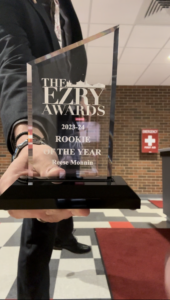The Annual Campus Security and Fire Report for the three year period 2012-2014 was released to students last week.
Since the signing of the Jeanne Clery Act in 1990, a law named after a Lehigh University student who was raped and murdered in her residence hall in 1986, the report has been a mandate.
“The incident triggered an investigation into all unreported crime on campuses across the country,” Jim Hutchins, Wittenberg’s chief of police, said.
The report is extensive in that it is required to address current campus crime report and emergency policies, off-campus crime policy, and Wittenberg’s alcohol and illegal drug policies and preventative program policies for both sex offenses and other crimes. It also includes descriptions of crime prevention programs, drug or alcohol abuse education, fire safety systems, policies and education and, lastly, crime and fire statistics.
The crime statistics listed in one of four categories — “murder,” “forcible sex offenses,” “other crimes” and “number of arrests and/or judicial referrals” for specific offenses — have undergone some changes in the past few years.
“The Violence Against Women Act (VAWA) was enacted in 2014, and began tracking the additional crimes of domestic violence, relationship violence and stalking. The act further broke down the statistic of forcible sexual assault into the two categories of forcible fondling and rape,” Hutchins said.
According to the on-campus statistics, there were 10 reports in 2012 and seven reports in 2011 of “unlawful sexual intercourse.” In 2014, there were four reports of rape and two reports of forcible fondling.
Reports of domestic violence, a non-listing in 2012, remained constant at zero since last year, whereas reports of relationship violence — also a non-listing — increased from one to three from 2013-2014. Reports of stalking increased from one to three as well.
Another addition was a statistic required by the Department of Education in 2015 called “unfounded crime.”
There was one unfounded burglary and two unfounded drug law violation referrals in 2014 on-campus. Despite the unfounded stat, burglary still ranked high on reported crime occurrences. In 2012, there were eight burglaries, compared to 19 in 2013 and 18 in 2014.
“The Department of Education counts burglary statistics differently than the Ohio Revised Code,” Hutchins said. “For example, in the 2014 statistics, one incident resulted in five statistics, according to the definition provided by the Department of Education. If the same incident were [sic] categorized under the Ohio Revised Code, it would be counted as one incident.”
Drug and alcohol violations also seem to be a point of rising concern. For drug violations on campus in 2012, there were no arrests and 16 referrals; in 2013, there were three arrests and 43 referrals; in 2014, there was one arrest and 61 referrals.
“The difference between an arrest and a referral is that an arrest results in a criminal charge and is handled through the court system. A referral is handled through the Student Development’s judicial process,” Hutchins said.
For alcohol violations on campus, there were five arrests and 110 referrals in 2012, five arrests and 71 referrals in 2013 and three arrests and 126 referrals in 2014 — fewer arrests, but more referrals.
On a more optimistic note, no murder nor negligent manslaughter have been reported in the last three years, on-campus robberies decreased from one in both 2012 and 2013 to zero in 2014, aggravated assault decreased from three to one to zero and there were no arrests or judicial referrals for illegal weapon possession across the three year span.
The report can be found online on the Wittenberg website.





